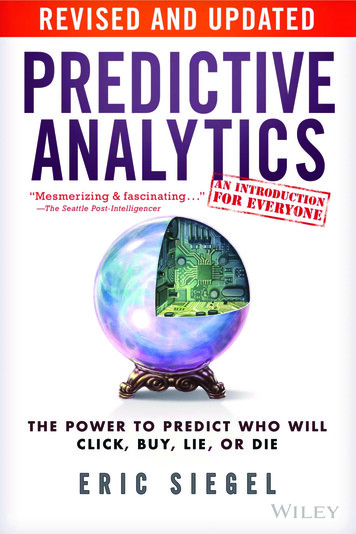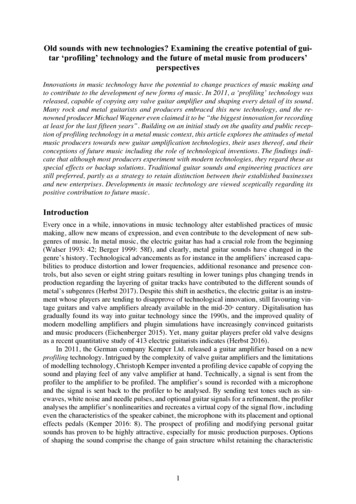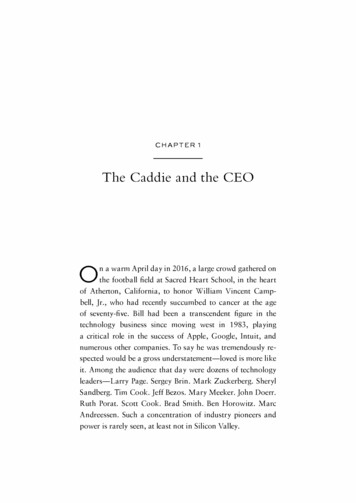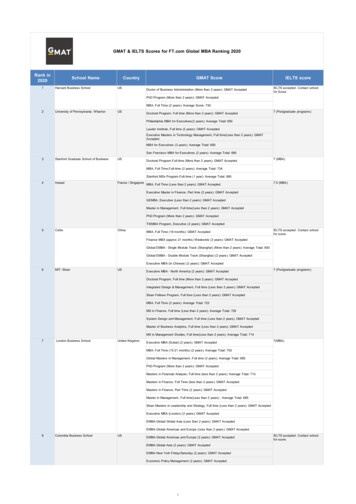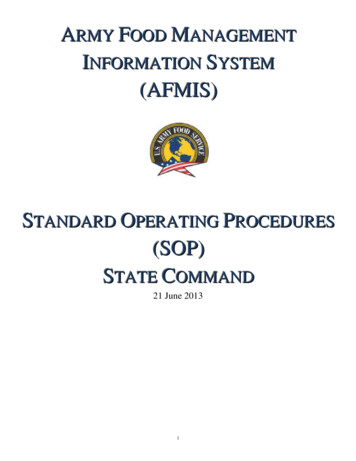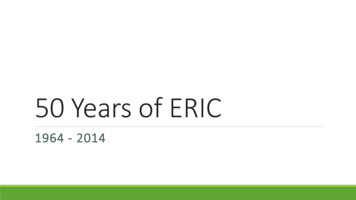
Transcription
50 Years of ERIC1964 - 2014
Illustrious History 50 years of service to education ResearchPracticeProfessional developmentDecision-making Innovation ThesaurusDisseminationTechnologiesContinuous, user-driven enhancements Known, respected, and searched worldwide2
Groundwork – Late Eisenhower Presidency1957 – 19581959Increase infederally fundedresearchOffice of Education(OE) commissionsfeasibility study31961OE coins acronym“ERIC”
1957 and 1958 – Defining the Need Elvis is “King” when the need for a reportrepository is recognized in the Office of Education. There was an increase in education research withno way to make the reports accessible to researchers,government officials, and the public.4
1959 to 1961 – Studying the Feasibility OE commissions “Feasibility Study Regarding the Establishment ofan Educational Media Research Information Service,” 1959. The study recommends that the service “embrace all educationresearch and research in other disciplines that have implicationsfor educational theory and practice.” Acronym ERIC coined at OE to stand for “Educational ResearchInformation Center,” 1961.5
1962-1965 – Kennedy and Early JohnsonPresidencies1962Western ReserveStudy – design forERIC19651964ERIC opens in OEPilot project“Fingertip”EDRS established6
1962 – Designing the System Western Reserve Study, “The Library of Tomorrow—Today,”published as the design for ERIC. ERIC’s services defined as computer tapes, copies of sourcedocuments, abstracts, bibliographies, and a thesaurus.7
1964 – ERIC Gets Its Start ERIC Program begins in the Office of Education on May 15. “It was an office without funds and an office without a program,”but early framers had big plans. Harold Haswell is first ERIC Director.8
The Year ERIC Begins – First Ford Mustang,Signing of the Economic Opportunity Act, HardDays Night (1964)9
1965 – Piloting Dissemination Project Fingertip pilots document dissemination to specialeducation teachers. Resources sent to all state Boards of Education, 100 largest cities,and a school district in each congressional district. Each packet contains 1,746 documents, with programdescriptions, indices, resumes, and the full text of each document.10
1965 – ERIC Document Reproduction Service(EDRS) OE decides to provide public access to indexed reports and othergrey materials. EDRS handles document reproduction for those wanting copies ofERIC documents. Microfiche is the state-of the art dissemination medium.11
Also in 1965. . . President Johnson signs PL 89-10, the “Elementary and SecondaryEducation Act” (ESEA) of 1965. “No Child Left Behind” is the current incarnation of ESEA.12
1966 – Rapid ExpansionFirst 12 ERICClearinghousesestablishedERIC Processing andReference FacilitycreatedMarch and JuneMayPhase 1 ERICThesaurus publishedJune13First issue of Researchin Education (RIE)publishedNovember
1966 – Expanding Capacity ERIC office quickly exceeds capacity for performing indexing. ERIC evolves into a decentralized system as OE awards contractsfor first clearinghouses to acquire and process materials,especially materials not accessible through traditional publishers. Clearinghouses are subject-centered and typically placed inuniversities and education associations. Harvey Marron is Director.14
1966 – ERIC Processing and ReferenceFacility Established as the scheduler and coordinator of the decentralizedERIC system. Hosted Thesaurus development and maintenance. Provided quality oversight to selection and indexing activities.15
1966 – ERIC Thesaurus Formally known as “The Thesaurus of ERIC Descriptors.” Designed as an authority list for the field of education. Widely used, respected and recognized as a standard in the field. The ERIC Thesaurus continues to develop and is available online.16
1966 – Research in Education (RIE) First printing of the abstract journal “Research in Education”signifies ERIC’s official opening to the public. The monthly RIE publication announces new documents added tothe ERIC database. The title was changed in 1974 from “Research in Education” to“Resources in Education.”17
Events in 1966 U. S. Department of Transportation formed. Ronald Reagan is elected Governor of California. U. S. engaged in combat in Vietnam.18
1967 – 1980 – ERIC Matures (Late Johnson,Nixon, Ford, and Carter Presidencies)1967 – 1969ERIC changes nameAdds journals1970 – 1972All 16 Clearinghouses on board1980ERIC available on DialogU. S. Department of Educationis formedERIC transfers to the NationalInstitute of Education19
1967 – 1980 ERIC changes name from “Educational Research Information Center” to“Educational Resources Information Center,” 1967.Journal literature added to ERIC database; first issue of “Current Index toJournals in Education” (CIJE) published, 1969.All 16 ERIC Clearinghouses on board, 1970.Dialog offers ERIC database online, 1971.ERIC transferred to newly created National Institute of Education (NIE), 1972.NIE transfers from the Department of Health, Education, and Welfare to thenewly formed Department of Education, May 1980.Chuck Hoover is ERIC Director.20
Events in the 1970s U. S. soldiers return home from Vietnam. Hippy era gives way to disco fever. First pocket calculator introduced.21
ERIC Clearinghouses 1-4 (with LatestAffiliation and Longest Serving Directors) Adult, Career, and Vocational Education, Ohio State University(Juliet Miller, Susan Imel) Assessment and Evaluation, University of Maryland (S. DonaldMelville, Lawrence Rudner) Community Colleges, University of California at Los Angeles(Arthur Cohen) Counseling and Student Services, University of North Carolina atGreensboro (Garry Walz)22
ERIC Clearinghouses 5-8 (with LatestAffiliation and Longest Serving Directors) Disabilities and Gifted Education, Council for Exceptional Children(Donald Erickson, Bruce Ramirez, Cassandra Peters-Johnson) Educational Management, University of Oregon (Philip Piele) Elementary and Early Childhood Education, University of Illinois(Lilian Katz) Higher Education, George Washington University (Jonathan Fife,Adrianna Kezar)23
ERIC Clearinghouses 9 -12 (with LatestAffiliation and Longest Serving Directors) Information & Technology, Syracuse University (Donald Ely,Michael Eisenberg, David Lankes) Languages and Linguistics, Center for Applied Linguistics (CharlesStansfield, Joy Peyton) Reading, English, and Communication, Indiana University (BernardO’Donnell, Carl Smith) Rural Education and Small Schools, Appalachia EducationalLaboratory (Everett Eddington, Craig Howley, Hobart Harmon,Timothy Collins)24
ERIC Clearinghouses 13-16 (with LatestAffiliation and Longest Serving Directors) Science, Mathematics, and Environmental Education, Ohio StateUniversity (Robert Howe, David Haury) Social Studies/Social Science Education, Indiana University (IrvingMorrissett, John Patrick) Teaching and Teacher Education, American Association of Collegesfor Teacher Education (Mary Dilworth) Urban Education, Teachers College, Columbia University (EdmundGordon, Erwin Flaxman)25
1981 – 1992 ERIC Goes Electronic (Reaganand Bush Presidencies)1981-1985500,000 ERIC entriesERIC on CD-ROMOffice of EducationalResearch andImprovement (OERI)is formed1989ACCESS 990 -1992ERIC on the InternetSpecial projectsbegan: AskERIC,GEM, VirtualReference Desk
1981 - 1989 ERIC database reaches 500,000 entries, 1983. ERIC database becomes available on CD-ROM, 1985. ERIC transfers to NIE’s successor, Office of Educational Researchand Improvement (OERI), 1985. ACCESS ERIC and first Adjunct Clearinghouses established, 1989. Bob Chesley, Chuck Hoover, Alan Moorehead are ERIC Directors.27
Events in the 1980s Motorola introduces first mobile phone. Space Shuttle Challenger explodes after take-off. Cold War ends with the fall of the Berlin Wall.28
1992 ERIC debuts on the Internet. AskERIC launched by the Information & Technology Clearinghouseat Syracuse University. Other special projects start up: Gateway to Educational Materials(GEM) and Virtual Reference Desk (VRD). Bob Stonehill is ERIC Director.29
ERIC Support Components (with LongestServing Directors) ACCESS ERIC – outreach and communications (Lynn Smarte). ERIC Document Reproduction Service – document conversion anddelivery (Peter Dagutis). ERIC Processing and Reference Facility – coordination, dataquality, and ERIC Thesaurus (Ted Brandhorst).30
1993 – 2003 – ERIC in the Internet Age (Clintonand Early George W. Bush Presidencies)1993ERIC beginsindexing books1994 - 19981999 – 2003National Library ofEducation (NLE)founded1 million ERICrecordsERIC transfers to NLEEDRS begins onlinedocument delivery31Institute ofEducation Sciencesfounded
1993 – 2003 ERIC adds books to the database, 1993. National Library of Education (NLE) founded, 1994. ERIC transfers to NLE, 1995. EDRS begins electronic document delivery, 1997. ERIC database reaches 1 million entries, 1999. ERIC joins the new Institute of Education Sciences (IES), 2002. Pat Coulter and Keith Stubbs are ERIC Directors.32
An ERIC Clearinghouse Website – 199733
AskERIC Website – 200134
ERIC Website – 200135
2002 – Education Reform Act Establishes theInstitute of Education Sciences (IES) ERIC Becomes Part of IES36
ERIC Website – 200337
2004 – 2012 – ERIC Redesigned (BushSecond Term and Obama Presidencies)20042005 - 2009ED consolidates ERICoperationsRelease of OnlineSubmission SystemERIC launches a singleweb portalMicrofiche DigitizationProject underway382010 - 2012Debut on social media1.4 million records inERIC
2004 U. S. Department of Education consolidates ERIC under a singlecontract. Production of microfiche ceases. ERIC becomes an all-electronic service. A single new website replaces 20 separate sites. Luna Levinson is ERIC Director.39
ERIC Website – 200440
2005 – 2012 ERIC opens Online Submission System for individual author papersand reports, 2005. ERIC digitizes legacy microfiche collection of 340,000 documents,2006 – 2009. ERIC establishes presence on Facebook and Twitter, 2010. Records in ERIC exceed 1.4 million, 2012.41
ERIC Website – 201242
2013 to Present – ERIC Transition (Phase 1)August 2013September –December 2013January 2014ERIC releases newstreamlined websiteReview of ERIC policiesand proceduresERIC adopts newSelection Policy43
ERIC Transition – August 2013 to January2014 ERIC releases new streamlined website at eric.ed.gov to enhanceusability and simplify searching for a broadening audience. Advisory Group formed to assist in review of collection policies. New Selection Policy adopted in January to focus on collectingeducation research. Erin Pollard is ERIC Program Officer.44
ERIC Transition – February 2014 ThroughRemainder of the Year (Phase 2)March 2014ERIC database andThesaurus madeopenly accessibleSpring/Fall 2014Remainder 2014New ERIC Topic Pagesunder developmentFurther enhancementsto increase usefulness45
ERIC Transition – February 2014 ThroughRemainder of the Year ERIC database and Thesaurus files made free and open fordownload without a license. ERIC developing topic pages with informative, peer-reviewedsummaries designed for a general audience and links to valuableresources. ERIC continues the long tradition of ongoing innovation andenhancement.46
ERIC Website – 201447
Special ThanksThe ERIC Team would like to extend recognition to: ERIC founders and early innovators: Office of Education - Thomas Clemens, Frank Schick, John Lorenz, Winslow Hatch, C. M.Flynt, Harold Haswell, Lee Burchinal, Harvey Marron. Western Reserve University – Allen Kent. University of Michigan – Frederick Goodman. Former Directors and staff from ED, ERIC Clearinghouses, EDRS, ERIC Facility,and ACCESS ERIC. Publishers and other contributors to the ERIC collection. ERIC searchers everywhere.48
For More ERIC History . . . Trester, Delmer J. (1979). “ERIC – The First 15 Years. A History ofthe Educational Resources Information Center.” Available fromhttp://eric.ed.gov (ED195289). Colker, Laura J. (2000). “Reminiscences From the Field: TheContinuing Story of ERIC.” Available from http://eric.ed.gov(ED437937).49
ERIC adds books to the database, 1993. National Library of Education (NLE) founded, 1994. ERIC transfers to NLE, 1995. EDRS begins electronic document delivery, 1997. ERIC database reaches 1 million entries, 1999. ERIC joins the new Institute of Education Sciences (IES), 2002. P

